Creating a marketing strategy is essential to effectively nurture your customers, improve your business’s bottom line, and increase the ROI of your efforts.
![Download Now: Free Marketing Plan Template [Get Your Copy]](https://no-cache.hubspot.com/cta/default/53/aacfe6c7-71e6-4f49-979f-76099062afa0.png)
A marketing strategy is especially critical if you want to use the highest ROI trends for 2023: short video, influencer marketing, and branded social media. To get powerful results, you must carefully weave both emerging trends and proven strategies into your plan.
Let’s dive into the critical components of a complete marketing strategy in 2023, followed by some examples for inspiration.
Marketing Strategy
A marketing strategy covers a company’s overall approach for promoting its brand to a target audience. The process involves research, goal-setting, and positioning.
A completed marketing strategy typically includes brand objectives, target audience personas, marketing channels, key performance indicators, and more.
A marketing strategy will:
- Align your team to specific goals.
- Help you tie your efforts to business objectives.
- Allow you to identify and test what resonates with your target audience.
- Empower you to capitalize on emerging trends.
The last one is especially important. Keeping up with marketing trends is important for your strategy, but could be a full-time job.
Why? Because almost 80% of marketers say this industry changed more in the last three years than it has in the past five decades. In short, what worked for your marketing strategy in the past might not fly today.
Marketing Strategy vs. Marketing Plan
A marketing strategy outlines the long-term goals and overall approach, while a marketing plan covers the specific actions and tactics to achieve those goals.
Phrased another way, marketing strategy guides the overall marketing efforts of a business. It includes goal-setting, market and competitor research, as well as messaging and positioning for a brand.
For example, say you’re creating a marketing strategy for a new fashion brand. Your strategy might target young urban professionals and position the brand as trendy and affordable.
But a marketing plan is a detailed tactical roadmap. It outlines the specific actions and tactics that should achieve the marketing strategy’s goals.
For example, the marketing plan for the fashion brand mentioned above might include:
- Targeted social media campaigns
- Influencer partnerships
- Online advertising timeline
Both a marketing strategy and a marketing plan are essential for a business’s success.
To succeed in the fast-paced marketing world — and maintain a sense of relevance with your audience — it’s vital to stay ahead of the curve.
To help ease some of that uncertainty, we’re going to show you step-by-step how to create a comprehensive marketing strategy. But first, let’s go over the individual components that make up a strong marketing strategy.
Marketing Strategy Components
- Marketing Mix (4 Ps of Marketing)
- Marketing Objectives
- Marketing Budget
- Competitive Analysis
- Segmentation, Targeting, & Positioning
- Content Creation (Including Trending Content)
- Metrics & Key Performance Indicators
1. Marketing Mix
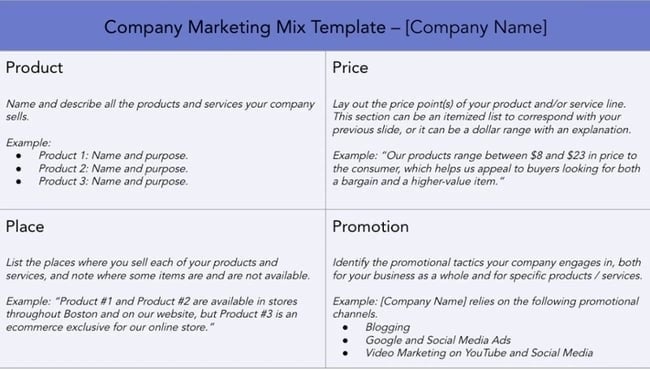
Image Source
The marketing mix, also known as the 4 Ps of marketing, is the preliminary document you must create to understand what you will be marketing, where you’ll be marketing it, and how you’ll be marketing it. The following P’s make up this framework:
- Product: What are you selling?
- Price: What is the price?
- Place: Where will you be selling the product?
- Promotion: Where will you be promoting the product?
You can then extrapolate this information into a full-fledged marketing plan for each promotional channel. It’s important to lay out the information in broad strokes so that you understand the overall direction of your marketing strategy.
2. Marketing Objectives
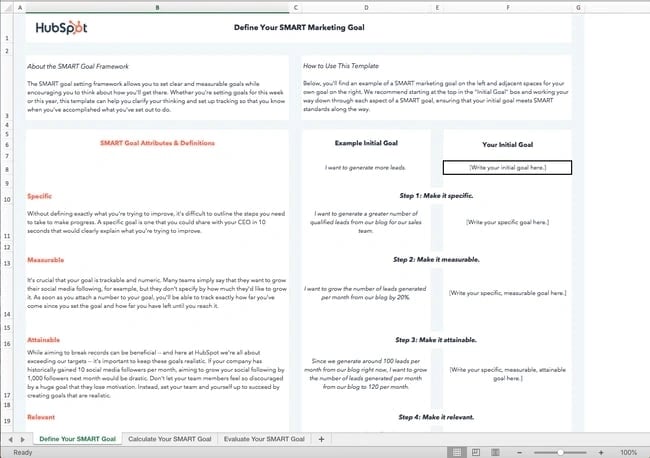
Image Source
You can set your marketing objectives in conjunction with your 4 Ps, or right after. Either way, you should outline your marketing goals before building upon your strategy. Why? Because your goals will inform other components of the plan, including the budget and content creation process.
With every objective, you should aim to be as specific as possible. Try to create SMART marketing goals divided by channel or promotional tactic, and don’t forget that you can always come back and revise your goals as your priorities change.
3. Marketing Budget

Image Source
A marketing budget is an essential element of your strategy. Without allocating funds to hiring the right talent, using the right software, advertising on the right channels, and creating the right content, your marketing strategy won’t have a powerful impact. To get a high return on investment, you must first invest.
Remember that you can always start small — hyper-focusing your budget on one or two efforts — and build upon them once you generate an ROI.
4. Competitive Analysis
Image Source
Knowing your competition is key when creating a marketing strategy. Otherwise, you risk “yelling into the void” without measurable results. Worse, you won’t know whether you’re differentiating yourself enough from the competition and effectively drawing the attention of your intended audience.
You might already have an idea of who your competitors are, but it’s still essential to sit down and find them. You might end up uncovering a surprise competitor who’s vying for your target buyer’s attention and engagement.
5. Segmentation, Targeting, and Positioning
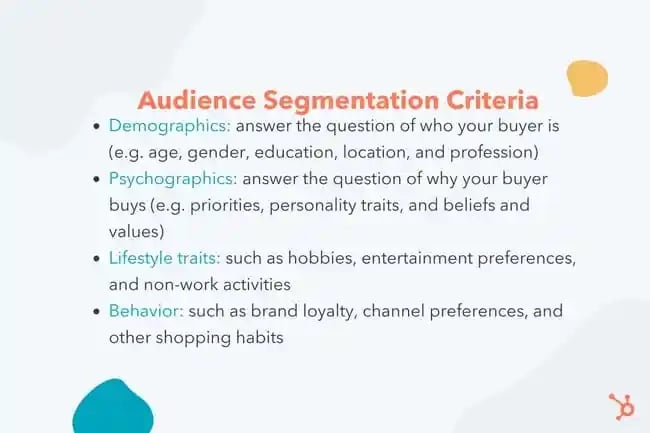
Segmentation, targeting, and positioning (STP) refers to the process of delivering “more relevant, personalized messages to target audiences.” In other words, rather than publishing posts and advertisements on a whim, you’ll go through a methodical process for creating content that resonates with your target buyer.
During the segmentation, targeting, and positioning process, you’ll take three steps:
- Identify your target audience. This process not only entails interviewing your current customers, but carrying out market research and creating buyer personas.
- Target a segment of your target audience. It’s best to speak to a narrow group of highly qualified buyers than to send your message out to everyone.
- Position your brand alongside other brands. What do you do better than your competitors? It’s essential to map this information when creating a marketing strategy.
6. Content Creation
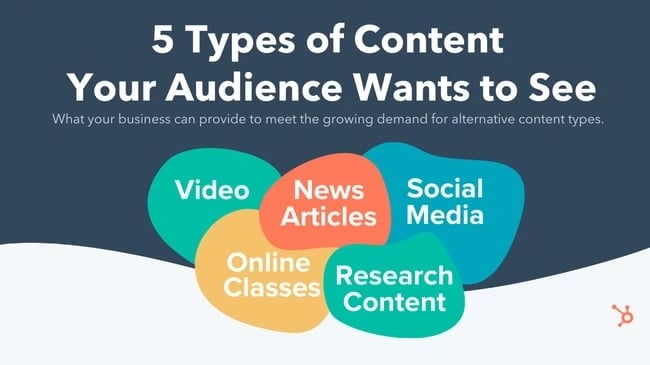
Image Source
Once you have your budget, competitive outlook, and STP information, it’s time to create your marketing content. But it’s essential to be strategic. For one, you don’t want to publish random content that doesn’t solve for the customer, and for two, you must aim to capitalize on emerging trends so that your brand enjoys high visibility in the marketplace.
The competition is fierce across all formats. According to HubSpot Research, “half of marketers are using videos, with 47% leveraging images, followed by 33% posting blogs articles, infographics (30%) and podcasts or other audio content (28%).” Of these, video has the highest ROI.
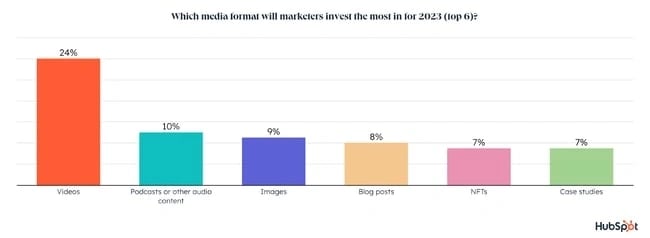 Click here to see a larger version of this image.
Click here to see a larger version of this image.
It’s even more essential to invest in trends that have a high ROI, such as short-form video, influencer marketing, and social media DMs.
That doesn’t mean you shouldn’t invest in blogging, one of the most proven content marketing techniques. It’s simply important to know where to allot the most resources, especially if you have a limited budget.
7. Metrics & Key Performance Indicators (KPIs)
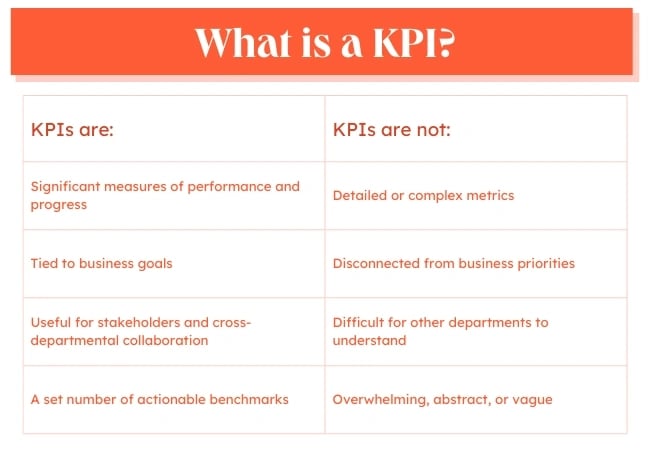
Image Source
Last, but certainly not least, your marketing strategy must include metrics and key performance indicators to understand how well your strategies are working. The KPIs you choose will vary depending on your business type and preferred customer acquisition channels. Examples of KPIs include:
Now, let’s dive into why it’s important to follow the steps of a marketing strategy.
Why is a marketing strategy important?
Without a defined strategy, you’ll essentially be throwing things at the wall to see what sticks. And that process will cost you money, time, and resources.
But a robust marketing strategy will reach your target audience. It has the power to turn people who’ve never heard of your brand into loyal repeat customers.
Here are just a few of the top reasons a marketing strategy is essential:
Offers Direction
A marketing strategy outlines clear goals and defines the path to achieve them. It pulls together all marketing efforts within an organization for optimal effects.
Targets the Right Audience
A well-defined marketing strategy helps you find and understand your target audience. This helps your business tailor your messaging and positioning to reach the right people at the right time.
Builds Brand Identity
A marketing strategy helps you create a consistent and cohesive brand identity. This makes it easier to align all marketing initiatives for increased brand recognition and loyalty.
Maximizes ROI
With analysis of market trends, competition, and customer behavior, marketing strategies help businesses find the most effective marketing channels and tactics to invest in. This helps businesses get the maximum return on investment.
Evaluates Performance
A marketing strategy defines key metrics and performance indicators. This makes it easier for your business to measure and track the success of marketing initiatives. It also gives you what you need to make data-driven decisions and optimize future campaigns for better results.
Marketing Strategy Process
- Conduct market research.
- Define your goals.
- Identify your target audience and create buyer personas.
- Conduct competitive analysis.
- Develop key messaging.
- Choose your marketing channels.
- Create, track, and analyze KPIs.
- Present your marketing strategy.
1. Conduct market research.
Before you can begin creating your marketing strategy, you need to gather useful data for making informed decisions. Market research is like playing detective, but instead of solving crimes, you’re uncovering juicy details about your customers.
Market research will help your businesses make data-driven decisions for your marketing strategy. It also makes it easier to understand your target market, find gaps, and make the most of your resources.
This process is essential for understanding your customers and adapting to changing trends. If you’re new to this process, this complete market research guide and template can help.
Once you have the data you need, you’ll be ready to set some marketing goals.
2. Define your goals.
What do you want to achieve through your marketing efforts?
Whether it’s increasing brand awareness, driving sales, or diversifying your customer base, well-defined goals will guide your marketing strategy.
Your marketing strategy goals should reflect your business goals. They should also offer clear direction for marketing efforts.
For example, say one of your business goals is to increase market share by 20% within a year. Your goal as a marketer could include expanding into new target markets, updating your brand, or driving customer acquisition.
Other marketing goals might be to increase brand awareness or generate high-quality leads. You might also want to grow or maintain thought leadership in your industry or increase customer value.
Defining clear goals provides direction and clarity, guiding marketing efforts toward desired outcomes. It helps with resource allocation, decision-making, and measuring the success of marketing initiatives.
This SMART goal guide can help you with more effective goal-setting.
3. Identify your target audience and create buyer personas.
To create an effective marketing strategy, you need to understand who your ideal customers are. Take a look at your market research to understand your target audience and market landscape. Accurate customer data is especially important for this step.
But it’s not enough to know who your audience is. Once you’ve figured out who they are, you need to understand what they want. This isn’t just their needs and pain points, it’s how your product or service can solve their problems.
So, if you can’t define who your audience is in one sentence, now’s your chance to do it. Create a buyer persona that’s a snapshot of your ideal customer.
For example, a store like Macy’s could define a buyer persona as Budgeting Belinda, a stylish working-class woman in her 30s living in a suburb, looking to fill her closet with designer deals at low prices.
With this description, Macy’s Marketing department can picture Budgeting Belinda and work with a clear definition in mind.
Buyer personas have critical demographic and psychographic information, including age, job title, income, location, interests, and challenges. Notice how Belinda has all those attributes in her description.
You don’t have to create your buyer persona with a pen and paper. In fact, HubSpot offers a free template you can use to make your own (and it’s really fun).
You can also use a platform like Versium, which helps you identify, understand, and reach your target audience through data and artificial intelligence.
Buyer personas should be at the core of your strategy.
4. Conduct competitive analysis.
Now that you have an understanding of your customers, it’s time to see who you’re competing with to get their attention.
To begin your competitive analysis, start with your top competitors. Reviewing their websites, content, ads, and pricing can help you understand how to differentiate your brand. It’s also a useful way to find opportunities for growth.
But how do you know which competitors are most important? This competitive analysis kit with templates will walk you through the process. It will help you choose and evaluate the strengths, weaknesses, and strategies of your competitors.
This process will help you find market gaps, spot trends, and figure out which marketing tactics will be most effective. Competitive analysis can also offer valuable insights on pricing, positioning, and marketing channels.
5. Develop key messaging.
You’ve figured out who you’re talking to, what they’ve already heard, and what they want to hear. Now, it’s time to share your brand’s unique value proposition.
In this step, you’ll craft key messaging that shows the benefits of your product or service and resonates with your target audience. This process should show off the research and work you have done up to this point. It should also incorporate your creativity, inventiveness, and willingness to experiment.
Well-crafted key messaging:
- Sets businesses apart from the competition
- Resonates with the target audience
- Is flexible enough to be consistent across all marketing channels
- Builds brand credibility
- Creates an emotional connection with customers
- Influences buying decisions
The key messaging in your marketing strategy is critical to driving engagement, loyalty, and business growth. These value proposition templates can help if you’re not sure how to draft this important messaging.
6. Choose your marketing channels.
You know what you have to say, now decide on the best marketing channels for your message. Your top goal for this stage of your strategy is to align your channel choices with your target persona’s media consumption habits.
Start with media channels you’re already using. Then, consider a mix of traditional and digital channels such as social media, TV, email marketing, podcast ads, SEO, content marketing, and influencer partnerships.
To streamline this process, think of your assets in three categories — paid, owned, and earned media.
Paid media

Paid media is any channel you spend money on to attract your target audience. Most of this spending is advertising. This includes online and offline channels like:
Owned Media
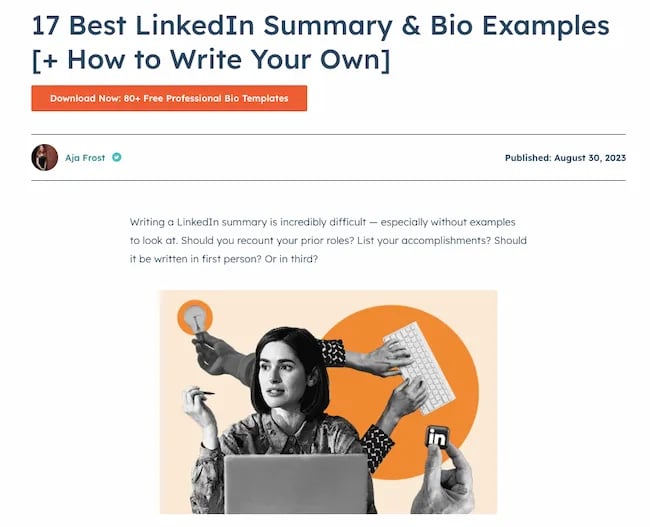
Owned media refers to (mostly) online channels your brand owns, including:
It also refers to the media your marketing team creates such as
Earned media
Another way to say earned media is user-generated content. Earned media includes:
- Shares on social media
- Posts about your business on X or Threads
- Reels posted on Instagram mentioning your brand
To decide which marketing channels are best for your marketing strategy, look carefully at each channel. Think about which channels are best for reaching your audience, staying within budget, and meeting your goals.
For example, a business targeting a younger demographic might consider using TikTok or Reddit to reach its audience.
Don’t forget to take a look at emerging platforms and trends as you complete this review. You may also want to look at the content you’ve already created. Gather your materials in each media type in one location. Then, look at your content as a whole to get a clear vision of how you can integrate them into your strategy.
For example, say you already have a blog that’s rolling out weekly content in your niche (owned media). You might consider promoting your blog posts on Threads (owned media), which customers might then repost (earned media). Ultimately, that will help you create a better, more well-rounded marketing strategy.
If you have resources that don’t fit into your goals, nix them. This is also a great time to clean house and find gaps in your materials.
7. Create, track, and analyze KPIs.
Once you have a clear outline of your marketing strategy, you’ll need to think about how you’ll measure whether it’s working.
At this stage, you’ll shift from marketing detective to numbers nerd. With a little planning and prep, your analytics can unveil the mysteries of marketing performance and unlock super insights.
Review your strategy and choose measurable KPIs to track the effectiveness of your strategy. Create a system that works for your team to collect and measure your data.
Then, plan to check and analyze the performance of your strategy over time. This can help you refine your approach based on results and feedback.
Analyzing KPIs helps businesses stay agile, refine their strategies, and adapt to evolving customer needs.
8. Present your marketing strategy.
A finished marketing strategy will pull together the sections and components above. It may also include:
Executive Summary
A concise overview that outlines the marketing goals, target audience, and key marketing tactics.
Brand Identity
You may want to create a brand identity as part of your strategy. Brand positioning, voice, and visual identity may also be helpful additions to your marketing strategy.
Marketing Plan and Tactics
Your marketing plan is the specific actions you’ll take to achieve the goals in your marketing strategy. Your plan may cover campaigns, channel-specific tactics, and more.
Not sure where to start? This free marketing plan template can help.
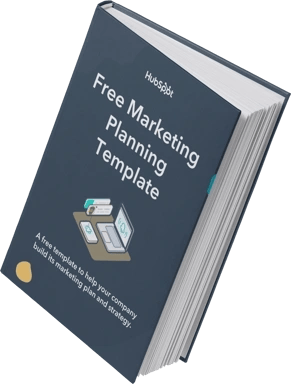
Download for Free
Budget Allocation
Defining a budget for your marketing strategy helps you show that your planned resource allocation aligns with business goals.
Timeline and Milestones
Marketing strategies can be complex and difficult for stakeholders to understand. Creating a timeline that outlines the different tactics, milestones, and deadlines can help.
Your marketing strategy is a living document. It will need constant reviews, revisions, and optimizations to meet your long-term goals. Prepare to revise your marketing strategy at least once a year to address market trends, customer feedback, and changing business objectives.
Recommended Resources
Here are a few tools that can help you track and measure the success of your marketing goals:
1. HubSpot Marketing Hub
The Marketing Hub allows you to connect all your marketing tools into one centralized platform.
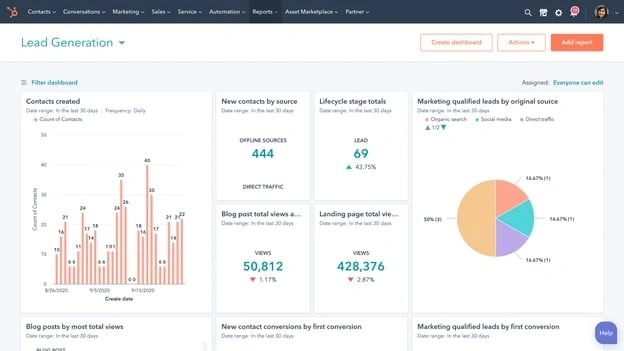
Too often, you’ll find a tool that’s powerful but not easy to use. With this tool, you can attract users with blogs, SEO, and live chat tools. You can then convert and nurture those leads through marketing automation, the website and landing page builder, and lead tracking features.
With custom reporting and built-in analytics, you can analyze your data and plan out your next move. Plus, HubSpot Marketing Hub integrates with over 700 tools.
Pricing: Free; Starter, $20/month; Professional, $890/month; Enterprise, $3,600/month.
2. Trello

Trello keeps your marketing team on track and openly communicating about the projects they’re working on. Create boards for individual campaigns, editorial calendars, or quarterly goals.
Built-in workflows and automation capabilities keep communication streamlined, and simplicity keeps your marketing team focused on the work that matters.
Pricing: Free; Standard Class, $5/month; Premium Class, $10/month for 100 users; Enterprise, $17.50/month for 250 users.
3. TrueNorth
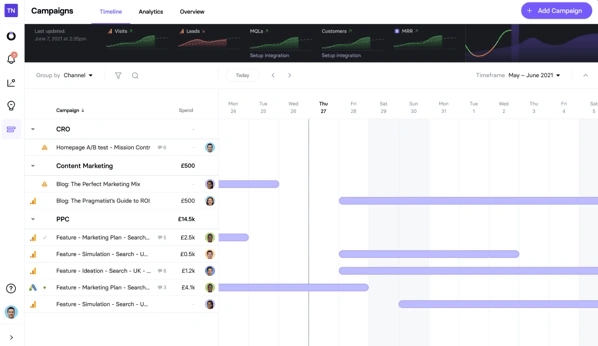
TrueNorth is a marketing management platform built to help you hit your marketing goals. Built specifically for marketing teams, TrueNorth turns your marketing strategy into a visual projection of your growth, which is used to create monthly milestones that help you stay on track.
One of the key benefits of TrueNorth is that it centralizes all your ideas, campaigns, and results in one place, with everything tied back to your goal.
Pricing: $99/month (free for 14 days).
4. Monday.com

Everything on Monday.com starts with a board or visually driven table. Create and customize workflows for your team and keep groups, items, sub-items, and updates synced in real time.
You can also transform data pulled from timeline and Gantt views to track your projects on Monday.com to make sure you’re meeting your deadlines. Plus, with more than 40 integrations — from SurveyMonkey to Mailchimp and, of course, HubSpot — you can visualize your data and make sure your whole company is collaborating.
Pricing: Basic, $8/month/seat; Standard, $10/month/seat; Pro, $16/month/seat; Enterprise, contact for pricing.
5. SEMrush
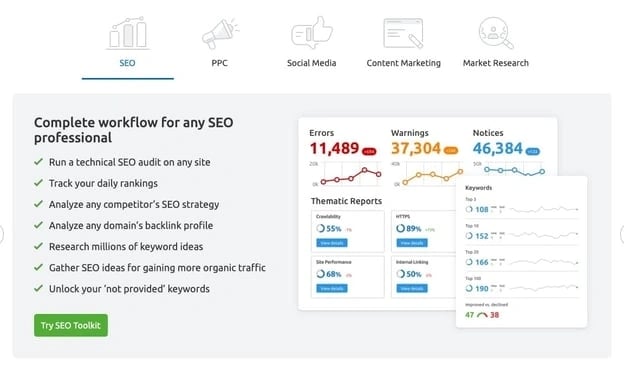
SEO continues to be a huge factor in the successful ranking of your website.
SEMrush allows you to run a technical SEO audit, track daily rankings, analyze your competitor’s SEO strategy, research millions of keywords, and even source ideas for earning more organic traffic.
But the benefits don’t stop at SEO. Use SEMRush for PPC, building and measuring an effective social media strategy, content planning, and even market research.
Pricing: Pro, $129/month; Guru, $249/month; Business, $499/month.
6. Buzzsumo

BuzzSumo allows you to analyze data to enhance and lead your marketing strategy, all while exploring high-performing content in your industry.
Use the platform to find influencers who may help your brand reach, track comments, and find trends to make the most of every turn.
As your needs evolve, you can also use their crisis management and video marketing tools.
Pricing: Content Creation, $199/month; PR&Comms, $299/month; Suite, $499/month; Enterprise, $999/month.
7. Crazy Egg
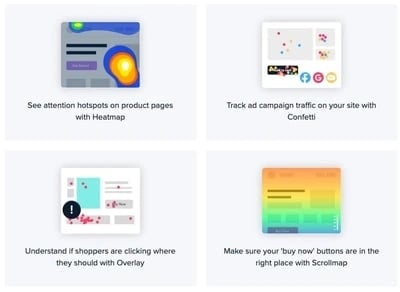
Need to optimize your website this year? Consider getting started with Crazy Egg. You’ll be able to identify “attention hotspots” on your product pages, track ad campaign traffic on your site, and understand if shoppers are clicking where you want them to.
You can even make sure your “Buy Now” buttons are in the best place.
Crazy Egg also offers recordings, A/B testing, and more to help make sure your website is offering the best user experience.
Pricing: Basic, $29/month; Standard, $49/month; Plus, $99/month; Pro, $249/month; Enterprise, contact for pricing.
Examples of Successful Marketing Strategies
1. Regal Movies
Digital Strategy: Owned Media
This “Guess the Monday Movie” question is a fun, interactive way to get followers invested in Regal’s content:
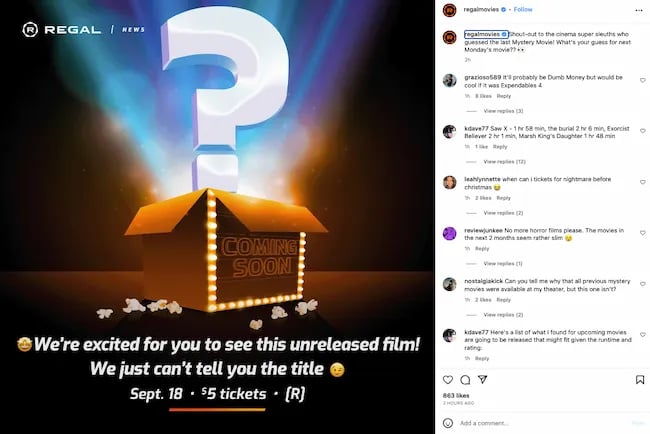
Image Source
Regal’s Instagram post is an example of owned media because the company was in full control of the answers followers gave (and, apparently, they’re hoping for fewer horror movies).
Regal kept true to their brand by asking viewers to guess the secret movie. And this is a popular type of post for this brand. In only two hours, it has over 800 likes and 64 comments.
2. La Croix
Digital Strategy: User-Generated Content, Earned Media
User-generated content is one of the best ways to gain traction in your strategy.
It demonstrates your appreciation for loyal customers, builds community, and incentivizes other users to promote your products for the chance at a similar shout-out.
Plus, sometimes the content your brand loyalists create is really, really good.

Image Source
In this case, the consumer is creating a handmade needlepoint featuring the brand’s product.
3. Small Girls PR
Digital Strategy: Owned Media

Image Source
Small Girls PR is a boutique PR company based in New York, and one of the company’s talents is connecting with amazing clients. This post on Instagram is an effective marketing example, as it boosts awareness for your brand and offers social proof by featuring high-profile clients.
4. Superside
Digital Strategy: Paid Media
Design agency Superside launched an Instagram ad to promote a lead magnet: Their digital ad design guide. While the brand may have created the guide specifically for paid promotions, it’s also possible that they repurposed a high-performing blog post into a downloadable ebook.

In this case, all they had to do was repackage their current content, build an ad around it with creative assets, and run it.
In previous sections, we discussed the power of leveraging multiple forms of media in your marketing strategy. This is a great example of it.
5. Target
Digital Strategy: Owned Media, Influencer Partnership
If you’ve got the time for influencer partnerships, take full advantage of it.
Influencer marketing is when you partner with influencers, to promote your content on their site. By doing this, your content reaches new audiences you might not be able to reach organically:
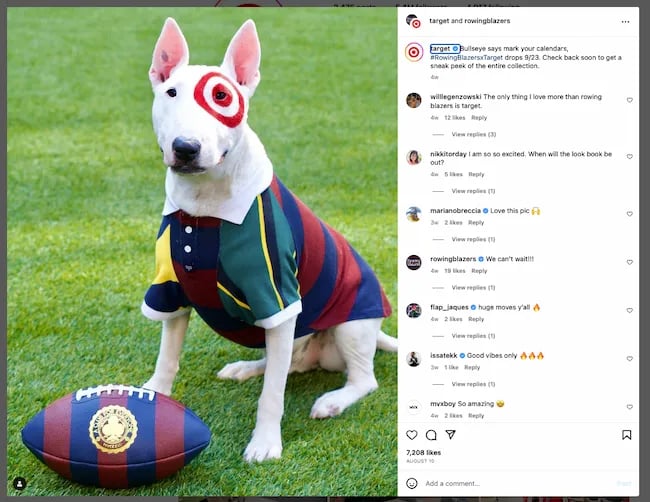
Image Source
This post from Target highlights new apparel from a trusted partner. More social channels are offering ways for shoppers to purchase in-app or close to it, driving sales and boosting exposure for brands.
What to Expect After Following Your Marketing Process Steps
Ultimately, creating a complete marketing strategy isn’t something that can happen overnight. It takes time, hard work, and dedication to confirm you’re reaching your ideal audience, whenever and wherever they want to be reached.
Stick with it (and use some of the resources we’ve included in this post), and over time, research and customer feedback will help you refine your strategy to make sure you’re spending most of your time on the marketing channels your audience cares most about.
Editor’s note: This post was originally published in October 2019. It has been updated for freshness and accuracy.

Credit: Source link


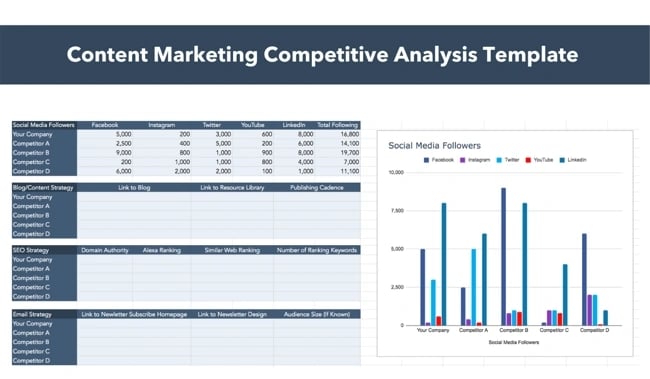






![What I’d Do to Stand Out on Every Platform [+ New Data] What I’d Do to Stand Out on Every Platform [+ New Data]](https://knowledge.hubspot.com/hubfs/social-media-marketing-campaign-1-20250418-2594108.webp)


